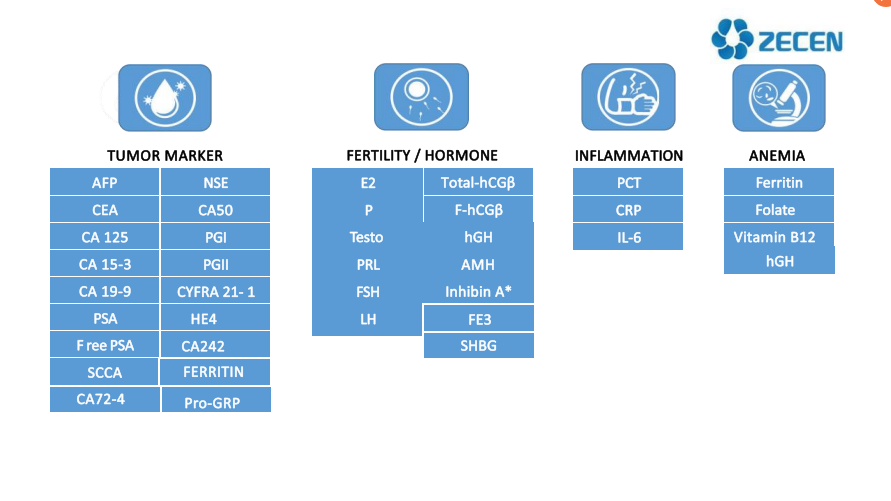Taizhou Zecen Biotech Co.,Ltd. |
|
CLIA Reagents of Inflammation (D-Dimer)
【Expected usage】
This product is used to quantitatively detect the content of
D-dimer (D-Dimer) in human plasma in vitro.
D-dimer is a specific degradation product produced by plasmin
hydrolysis after fibrin monomer is cross-linked by activating
factor XIII. It is a specific marker of fibrinolysis process.
D-dimers are derived from cross-linked fibrin clots lysed by
plasmin.
The fibrinolytic system is the most important anticoagulant system
in the human body and consists of four main components:
plasminogen, plasminogen activator, plasmin, and plasmin inhibitor.
When a fibrin clot is formed, in the presence of a plasminogen
activator, plasminogen is activated and converted to plasmin, the
fibrinolytic process begins, and plasmin degrades the fibrin clot
to form various soluble fragments, forming Fibrin product, fibrin
product consists of the following substances: X-oligomer, D-dimer,
intermediate fragment, fragment E. Among them, X-oligomer and
D-dimer both contain D-dimer units.
The human fibrinolytic system plays an important role in
maintaining the normal permeability of the blood vessel wall,
maintaining blood flow and tissue repair. Increased plasma levels
of D-dimer indicate a secondary fibrinolytic process with thrombin
production followed by activation of the fibrinolytic system.
Thrombolytic therapy refers to the use of drugs to activate the
fibrinolytic system. Generally, a plasminogen activator, such as
urine enzyme, streptokinase or tissue-type plasminogen activator,
is used to generate a large amount of plasmin, thereby accelerating
the dissolution of thrombosis.
D-dimer mainly reflects fibrinolytic function. Increased or
positive seen in secondary hyperfibrinolysis, such as
hypercoagulable state, disseminated intravascular coagulation,
renal disease, organ transplant rejection, thrombolytic therapy,
etc. As long as there is active thrombosis and fibrinolysis in the
body's blood vessels, D-dimer will increase. Myocardial infarction,
cerebral infarction, pulmonary embolism, venous thrombosis,
surgery, disseminated intravascular coagulation, infection and
tissue necrosis can lead to elevated D-dimer. Especially for the
elderly and hospitalized patients, due to bacteremia and other
diseases, it is easy to cause abnormal blood coagulation and lead
to increased D-dimer.
The current clinical and laboratory determination methods of
D-dimer include enzyme-linked immunosorbent assay, colloidal gold
method, fluorescence immunoassay, and chemiluminescence method.
【Inspection Principle】
This kit adopts the principle of direct sandwich method, uses
magnetic microparticles as the solid phase of immune reaction, and
uses chemiluminescence enzyme-linked immunosorbent assay method to
cooperate with chemiluminescence measuring instruments to detect
D-dimer (D-Dimer) in human plasma. )content.
The technical principle is: Fluorescein isothiocyanate
(FITC)-labeled mouse monoclonal anti-D-Dimer antibody paired with
alkaline phosphatase (AP)-labeled mouse monoclonal anti-D-Dimer
antibody and samples, calibrators or The D-Dimer in the control
product binds to form a "sandwich" complex. Subsequently, the
magnetic particles linked with goat anti-fluorescein isothiocyanate
(FITC) antibody were added, and the antigen-antibody immune
complexes were bound to the magnetic particles through the specific
binding of the anti-FITC antibody to FITC.
Under the action of an external magnetic field, the complex formed by the immune reaction is separated from other unbound substances, and after washing the complex, an enzymatic chemiluminescent substrate (adamantane derivative) is added. The substrate is catalytically cleaved under the action of the enzyme to form an unstable excited state intermediate.
When the excited state intermediate returns to the ground state, photons are emitted to form a luminescence reaction, and the luminescence intensity of the reaction can be detected by a chemiluminescence instrument. In the range of measurement wavelength (230-700nm), the luminescence intensity is proportional to the content of D-Dimer in the sample, and the D-Dimer concentration in the sample can be calculated by fitting the modified four-parameter Logistic equation.
| Test Item | D-Dimer |
| Luminescent Principle | Enzymatic chemiluminescence |
| Luminescent Markers | AP(alkaline phosphatase) |
| Specification | 100 Test/Kit for CIA series |
| 24 Test/Kit for Poclia | |
| Principle | Sandwich method |
| Component | Magnetic Beads |
| Calibrator Low | |
| Calibrator High | |
| Anti-A/Anti-B | |
| Control 1 | |
| Control 2 | |
| Accessories Required But Not Provided | Substrate |
| Washing solution | |
| Sample material | Serum |
| Storage | 2-8℃ |





